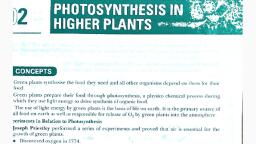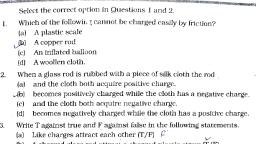Page 1 :
ee eee NS EE Se ee eed SON eA ee eo Te ce ee ee, Ans: Activity to be done by the student,, , Chapter 15—Some Natural Phenomena, , Select the correct option in Questions | and 2., , 1, Which of the following cannot be charged easily by friction?, (a) A plastic scale, (b) A copper rod, (c) An inflated balloon, (d) A woolen cloth., Ans: (b) A copper rod, , 2. When a glass rod is rubbed with a piece of silk cloth the rod, (a) and the cloth both acquires positive charge., (b) becomes positively charged while the cloth has a negative charge., (c) and the cloth both acquire negative charge., (d) becomes negatively charged while the cloth has a positive charge., Ans: (b) becomes positively charged while the cloth has a negative charge., , 3, Write T against true and F against false in the following statements:, (a) Like charges attract each other (T/F), (b) A charged glass rod attracts a charged plastic straw (T/F), (c) Lightning conductor cannot protect a building from lightning (T/F), (d) Earthquakes can be predicted in advance (1/F), Ans: a.F b. Tc. Fd. F, , 4, Sometimes, a crackling sound ts heard while taking off sweater during winters, Explain., Ans: Sweater is made of wool, When the sweater is taken off, it rubs against the body. Rubbing allows the electrons to move between, the positively charged surface of the body and the negatively charged sweater. When the electrons move through the air, they heat up, the air to cause sparks and crackling sounds,, , 5, Explain why a charged body loses its charge If we touch it with our hand., Ans: A charged body loses its charge when we touch it with hand because the charge gets transferred through our body to the Earth., , , , , , , , , , , , , , , , , , , , , , , , , , , , , , 33 *































































